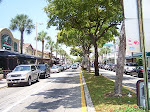The largest city in the area is Malaga. Originally settle approximately 3000 years ago by the
 Phoenicians, its control has passed to all the major players in the Mediterranean. The Romans were the first major empire to control the area, then came the Moors, with the unification of Spain at the end of the 15th Century, the area was once again under Spanish control.
Phoenicians, its control has passed to all the major players in the Mediterranean. The Romans were the first major empire to control the area, then came the Moors, with the unification of Spain at the end of the 15th Century, the area was once again under Spanish control.With each conqueror, archaeological evidence can be found. There is a 1st Century BC Roman theater. It was only discovered by accident in the early 1950s. The main hill in the city is covered by rebuilt Moorish fortifications. Originally built in the 11th Century and rebuilt in the 13th and 14th. It dominates the hilltop with its encircling walls. The grounds are open and are
 filled with gardens and information on the history of the area. It has become a major tourist attraction for the area and offers spectacular views of the harbor and the surrounding countryside.
filled with gardens and information on the history of the area. It has become a major tourist attraction for the area and offers spectacular views of the harbor and the surrounding countryside.In the lower city, there is the Governor's Palace, many gardens and the required bullring. In the harbor is a ship from the famed Spanish Armada, which is open for tours and also as a venue for
 functions. Also in the modern area of town is the birthplace of Pablo Picasso. Fronting one of the main squares it has been turned into a museum of the famed artist's life. Another fantastic piece of artwork from Malaga is Antonio Banderas. Saw the Picasso house, but the search for Antonio was a bust.
functions. Also in the modern area of town is the birthplace of Pablo Picasso. Fronting one of the main squares it has been turned into a museum of the famed artist's life. Another fantastic piece of artwork from Malaga is Antonio Banderas. Saw the Picasso house, but the search for Antonio was a bust.The main shopping area for Malaga is alongside the waterfront. It is a series of
 streets closed to vehicular traffic which allows for casual strolling and lots of people watching from the many sidewalk cafes. Leather goods predominate the local goods. During the time I was in Malaga, these shopping streets were the
streets closed to vehicular traffic which allows for casual strolling and lots of people watching from the many sidewalk cafes. Leather goods predominate the local goods. During the time I was in Malaga, these shopping streets were the  backdrop for sculptures by Auguste Rodin. There were many works by the acclaimed French sculptor with identifying plaques. His masterpiece The Thinker
backdrop for sculptures by Auguste Rodin. There were many works by the acclaimed French sculptor with identifying plaques. His masterpiece The Thinker  was placed at the south entrance welcoming shoppers to buy.
was placed at the south entrance welcoming shoppers to buy.Part of the Spanish cuisine is tapas. Not a specific food item, it is a collection of appetizers. Small plates that offer a bite or two of a food item. They range from
 marinated and grilled vegetables to beef, or seafood. With its proximity to the coast, Malaga has a fantastic array of fresh seafood. Sardines and anchovies are popular in tapas. Spending an afternoon with friends sitting and enjoying wine and tapas is a popular passtime in Spain, and with Malaga's near perfect weather, it is a year round activity.
marinated and grilled vegetables to beef, or seafood. With its proximity to the coast, Malaga has a fantastic array of fresh seafood. Sardines and anchovies are popular in tapas. Spending an afternoon with friends sitting and enjoying wine and tapas is a popular passtime in Spain, and with Malaga's near perfect weather, it is a year round activity.So if the search for the roots of Picasso, or Antonio Banderas awakens your wanderlust. Try Malaga on Spain's Costa del Sol. It offers architecture, history, fantastic seafood, and is a good base for exploring southern Spain. It is just a short drive from Seville and Torremolinos, and we have all heard stories about there. The agents at Damron Vacations can help plans your Iberian Escape and maybe you will be luckier than me and find Antonio B.





No comments:
Post a Comment